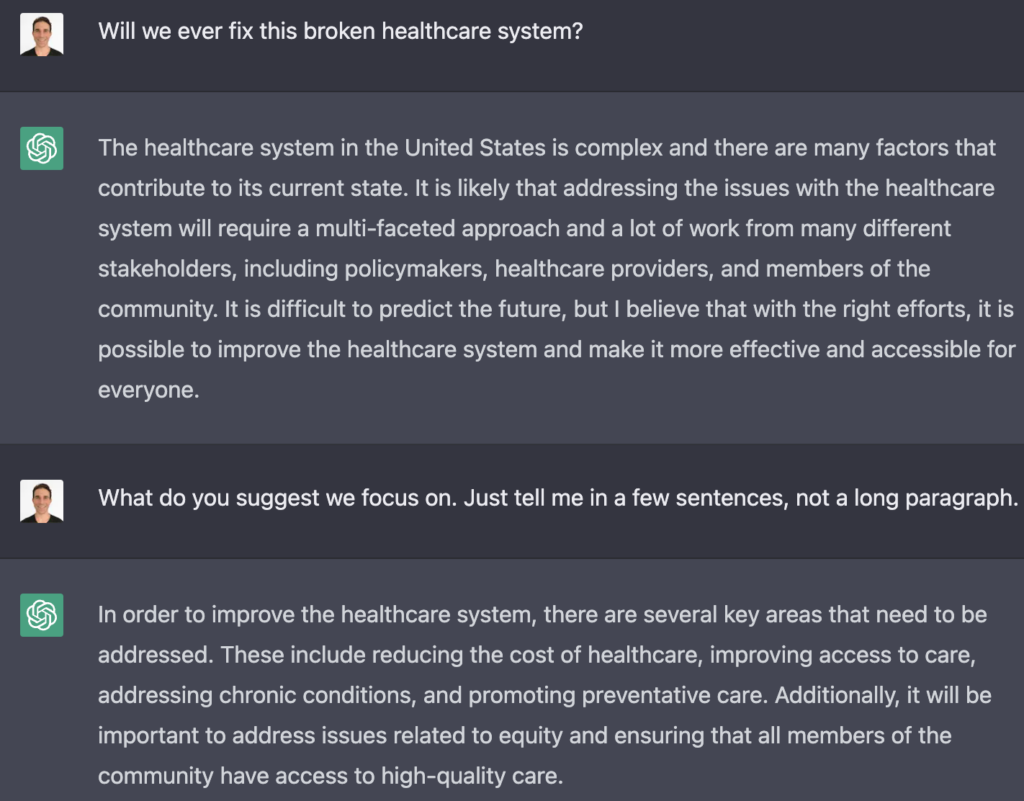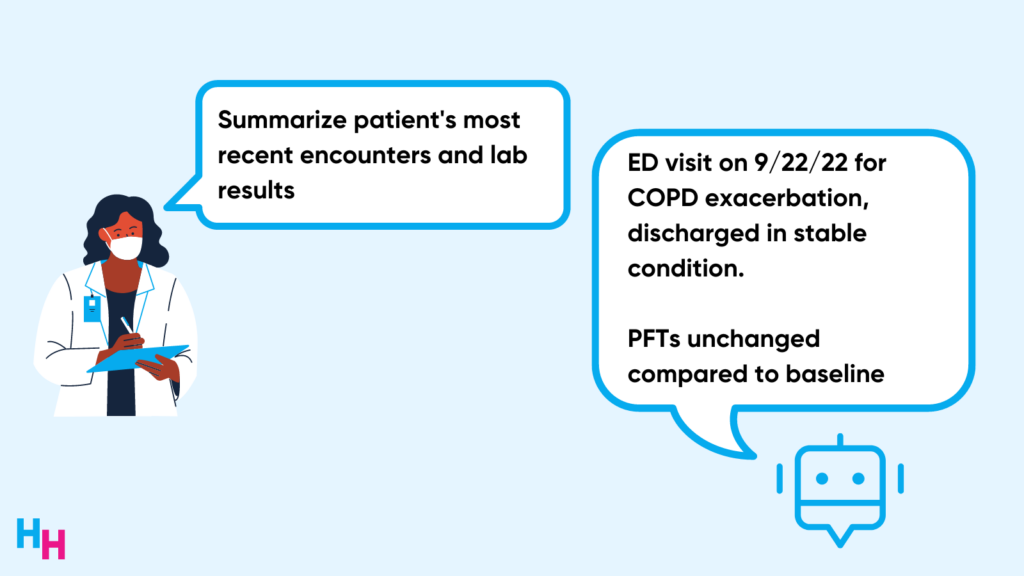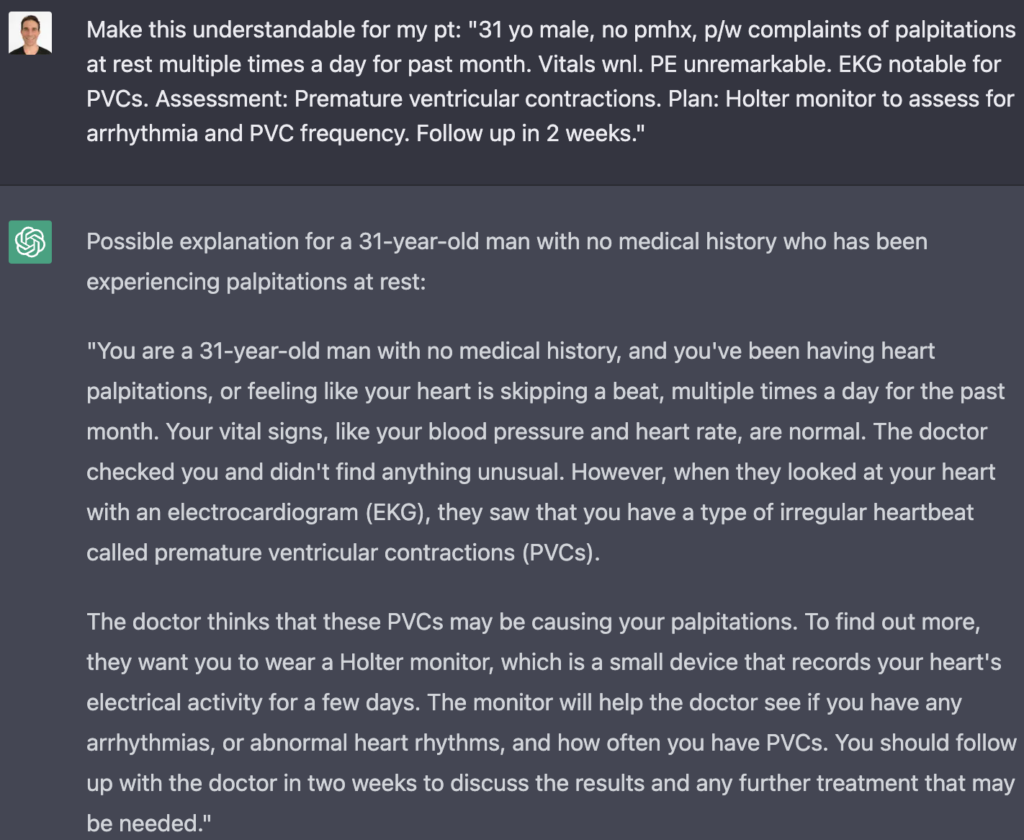10 December 2022 | Healthcare
The Future of Natural Language Processing in Healthcare
By workweek
OpenAI’s natural language processing platform ChatGPT launched a couple of weeks ago and has since gained tremendous traction, surpassing one million users within weeks. For some perspective, it took Netflix three and a half years to reach one million users!
ChatGPT is a robust platform that has tremendous implications, especially in healthcare. I believe it could be the next stethoscope—a tool every provider (and patient) can access. While natural language processing is an intimidating term for those unfamiliar with artificial intelligence (including me!), don’t stop reading. I’ll explain everything.
In this week’s Huddle, I’ll simplify natural language processing and ChatGPT, discuss the healthcare implications of the platform, and shed light on the challenges facing its use in healthcare.
What is Natural Language Processing?
Natural language processing is exactly what it sounds like—processing natural language. It’s a subset of artificial intelligence focused on enabling computers to understand, interpret, and manipulate human language. So, for example, I asked ChatGPT the following:

There are two core components of natural language processing:
- Natural language understanding
- Natural language generation
Natural language understanding involves analyzing and interpreting unstructured data input (speech, written text, images), answering the question: “what does this mean?” Some of the analysis used for natural language understanding includes speech recognition, syntax (sentence structure and grammar), semantic (meaning), and sentiment (feelings, like sarcasm) analysis. For example, natural language understanding must differentiate the use of “stomach” below:
- “Jared is fascinated by the stomach and intestines.”
- “Jared couldn’t stomach the news.”
Natural language generation involves creating human-like responses based on input, simple as that.
Now, ChatGPT is a natural language processing chatbot built by OpenAI. It is a powerful tool that can analyze whatever you write and respond like it’s your buddy. So here’s a conversation I had with ChatGPT about fixing healthcare:

ChatGPT can process input efficiently and produce a sensible output in most cases. The ability of ChatGPT to quickly analyze unstructured data, make sense of it, and produce an output is exciting, especially when you think about its potential implications in healthcare.
Healthcare Implications of ChatGPT
ChatGPT, and other natural language processing platforms in general, can benefit healthcare in three core areas:
- Patient care and delivery
- Research, diagnostics, and treatment
- Clinical and non-clinical workflow
Patient care and delivery
ChatGPT can improve patient care and delivery through triaging, detecting errors, and engaging patients in their care plans.
ChatGPT can serve as a first-line care chatbot for patients with low-acuity and classic illness presentations. For example, say a patient wakes up today with a fever, sore throat, runny nose, fatigue, and muscle pain. The patient could log on to their patient portal and explain their current symptoms to the chatbot. The chatbot may ask, “have you been around anyone who’s been sick,” to which the patient may reply, “yes!” Knowing the time of year and real-time prevalence of viral illness, the chatbot may determine a 90% probability that this patient has a low-acuity, viral illness like the flu. Supportive care is all that’s needed, and the patient should be instructed to go to the emergency department if symptoms worsen. Thus, the patient received a timely response and effective care plan without needing to see a physician or risk infecting others.
To err is human, and there are plenty of errors made in medical delivery. ChatGPT could read a physician’s care plan note in real-time and detect any errors that may cause patient harm. For example, a physician may write in their note for the patient to take two medications, not knowing that there’s a harmful drug-drug interaction, which ChatGPT would detect and prevent. While drug interactions are already detected in EHRs, it’s only done as the meds are being prescribed, not when the physician writes it earlier in their note.
Additionally, ChatGPT could effectively engage patients in their care. ChatGPT could follow up with patients to see how they’re adhering to their medications or other treatment plans and if they have any questions. For patients with hypertension and remote patient blood pressure monitoring, ChatGPT could continuously analyze blood pressure readings and reach out to the patient if their readings have been high. “Have you been taking your meds?” If not, then ChatGPT can engage in discussion. If they have been taking the meds, then the physician could be notified to increase the dosage of BP meds.
Research, Diagnostics, and treatment
ChatGPT can augment clinical researchers’ ability to run studies and providers’ ability to diagnose and treat disease.
Clinical researchers can use an EHR’s ChatGPT to aggregate specific patient populations needed for their study. EHRs are messy, with troves of disorganized patient information. So imagine a clinical researcher asking ChatGPT, “provide me with average blood pressure readings between 2020 and 2022 for 1,000 de-identified patients with and without hypertension. Make sure the patient population provided is reflective of the general population. Exclude patients with type II diabetes.” Instead of spending days or weeks chart reviewing (shoutout to the researchers who’ve done this), ChatGPT could produce a CSV file with all the data within minutes.
Along the same lines, providers can use ChatGPT to aid in diagnosis by quickly gathering patient information, including medical history, medications, allergies, latest results, and summaries of prior visits. Providers chart review before seeing patients, which is time-consuming as they click through several prior encounters to determine if there’s anything significant. Instead, providers can ask ChatGPT to summarize the patient’s prior visits, if there were any emergency department visits (e.g., the patient frequently comes to ED with COPD exacerbation), and any abnormal lab results. This would provide a more complete picture of the patient’s current presentation, aiding in diagnosis. ChatGPT could also listen to the provider-patient conversation to produce can’t-miss differentials and rank the provider’s differentials by likelihood.

Regarding treatment plans, providers can use ChatGPT to write treatment plans based on the successes or failures of the patient’s past treatment and current problem. The provider can make appropriate edits to the treatment plan. Additionally, ChatGPT can review the provider’s note and transform the language so the patient can understand it, improving their health literacy.

Clinical and non-clinical workflows
Hospitals and independent practices can use ChatGPT to streamline their workflows.
Patients can use ChatGPT to schedule appointments and ChatGPT can analyze the provider’s schedule to streamline their workflow. For example, ChatGPT could optimize a provider’s schedule by scheduling all new patients in the morning and follow-up patients in the afternoon. If there’s only one available appointment far out, ChatGPT could add the patient to a waitlist. When another patient cancels their earlier appointment, ChatGPT could reach back out to the patients on the waitlist and try to fill the open slot. This would increase access to care and save offices potential revenue loss (I talked about this in a newsletter a couple of months ago!).
Offices can also use ChatGPT to make referrals. For example, if a patient comes to their PCP and needs a cardiologist referral, the patient’s PCP can ask ChatGPT, “find a cardiologist nearby that accepts this patient’s insurance and schedule them for a follow-up. Provide a summary of this visit to the cardiologist’s office.” That easy.
Lastly, ChatGPT can be used for prior authorization and reimbursement. ChatGPT could handle prior authorizations by reviewing the insurance companies’ guidelines and patients’ records, creating responses that effectively fall within the insurer’s guidelines. This would save offices an immense amount of time and frustration. And, ChatGPT could review the provider’s note for a patient and determine the appropriate ICD code for reimbursement. I’m sure ChatGPT could be optimized for the highest reimbursement.
Dash’s Dissection
The healthcare implications of ChatGPT are endless. Thinking through natural language processing platforms’ impact on healthcare is exciting, especially since they have the potential to improve patient care and streamline mundane, wasteful processes. While several of the natural language processing applications I discussed are already in the works, if not already used, it’s unlikely they’re running as robustly as ChatGPT can.
As we all know, nothing works out perfectly in healthcare, which is why several hurdles must be jumped before making ChatGPT, or similar platforms, a tool as common as the stethoscope.
First, ChatGPT has no regard for the truth. So, users can’t tell if a reply is wrong unless they know the answer or have a sense of what the answer may be. This doesn’t mean, though, that ChatGPT is always wrong, as evidenced by the examples I provided above.
Second, there’s little healthcare regulatory oversight on artificial intelligence. It’s well known that artificial intelligent models, including ChatGPT, have inherent biases since they’re trained by humans who, obviously, have their own biases. So, without regulation, these platforms can perpetuate biases that may lead to morbidity and mortality.
Lastly, the knee-jerk reaction to artificial intelligence is the fear that it will replace jobs. I stand my ground when I say artificial intelligence should only replace mundane processes void of creative thinking or problem-solving. Artificial intelligence should be used to augment creative thinking and problem solving, like helping a physician catch errors or saving physicians documenting time to focus on the patient. Artificial intelligence, then, has a high potential to improve the art of medicine.
In summary, natural language processing platforms such as ChatGPT have the potential to revolutionize healthcare. Specifically, ChatGPT can be used to improve patient care, research, and workflows to allow more time for creative thinking and problem-solving. However, these artificial intelligent platforms face several hurdles, such as truthfulness, regulatory oversight, and trust. We are only in the flip phone stage of artificial intelligence—the future of healthcare will be riveting.
If you enjoyed this deep dive, share it with colleagues. Sign up for the Healthcare Huddle newsletter here.